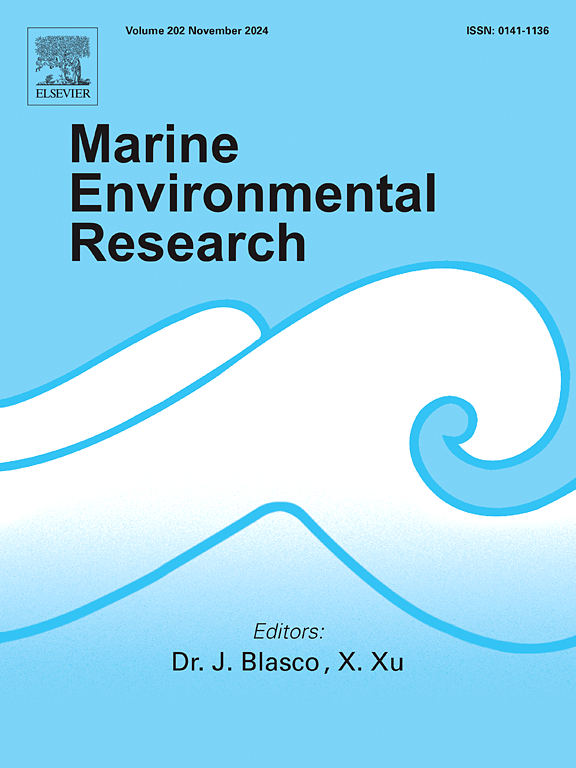Calcium carbonate production by the massive coral Mussismilia hispida in subtropical reefs of the Southwestern Atlantic
IF 3
3区 环境科学与生态学
Q2 ENVIRONMENTAL SCIENCES
引用次数: 0
Abstract
Corals, as primary calcifiers, play a vital role in synthesizing calcium carbonate (CaCO3) to build their skeletons, contributing to the formation of complex benthic habitats that support high biodiversity and marine productivity. However, coral habitats have dramatically declined worldwide due to ocean warming and acidification. Interestingly, the subtropical Southwestern Atlantic (SWA) has emerged as a potential refuge, where corals like Mussismilia hispida exhibit resilience to thermal anomalies. In this study, we estimate CaCO3 production by M. hispida in subtropical SWA reefs, revealing an average growth rate of 4.3 ± 1 mm/year and a CaCO3 production rate of 1.31 ± 0.3 kg. m−2. year−1. These values are comparable to tropical reef systems, suggesting that M. hispida contributes significantly to carbonate production, even in higher latitude environments. Moreover, despite experiencing one of the most intense thermal anomalies recorded, colony abundance (i.e., ind. m−2) and carbonate production remained stable, emphasizing the potential of the region as a climate refuge. While many tropical reefs act as net CO2 sources due to the release of CO2 during calcification, SWA subtropical reefs present lower coverage of corals. They are dominated by algae and other primary producers, acting as an important potential carbon sink through photosynthesis and long-term storage of carbon over centuries as mineralized CaCO3. Thus, we provide evidence that M. hispida, by producing ∼170 tons. year−1 of CaCO3 in the subtropical reefs of the Alcatrazes Archipelago, acts as a key player in carbon sequestration and CaCO3 production in higher latitude SWA areas.
西南大西洋亚热带珊瑚礁中巨大珊瑚Mussismilia hispida的碳酸钙生产
珊瑚作为初级钙化剂,在合成碳酸钙(CaCO3)以构建其骨骼方面发挥着至关重要的作用,有助于形成复杂的底栖生物栖息地,支持高生物多样性和海洋生产力。然而,由于海洋变暖和酸化,珊瑚栖息地在世界范围内急剧减少。有趣的是,亚热带西南大西洋(SWA)已经成为一个潜在的避难所,在那里,像Mussismilia hispida这样的珊瑚表现出对热异常的弹性。在本研究中,我们估计了亚热带SWA珊瑚礁中M. hispida的CaCO3产量,结果显示其平均生长率为4.3±1 mm/年,CaCO3产量为1.31±0.3 kg。m−2。年−1。这些值与热带珊瑚礁系统相当,表明即使在高纬度环境中,M. hispida也对碳酸盐的产生有重要贡献。此外,尽管经历了有记录以来最强烈的热异常之一,但群落丰度(即indi - 2)和碳酸盐产量保持稳定,强调了该地区作为气候避难所的潜力。由于钙化过程中二氧化碳的释放,许多热带珊瑚礁成为二氧化碳的净来源,而西南海区亚热带珊瑚礁的珊瑚覆盖率较低。它们以藻类和其他初级生产者为主,通过光合作用作为重要的潜在碳汇,并以矿化CaCO3的形式长期储存碳长达几个世纪。因此,我们提供的证据表明,m.s hipida,生产约170吨。Alcatrazes群岛亚热带珊瑚礁CaCO3的年- 1,在高纬度SWA地区的碳固存和CaCO3生产中起着关键作用。
本文章由计算机程序翻译,如有差异,请以英文原文为准。
求助全文
约1分钟内获得全文
求助全文
来源期刊

Marine environmental research
环境科学-毒理学
CiteScore
5.90
自引率
3.00%
发文量
217
审稿时长
46 days
期刊介绍:
Marine Environmental Research publishes original research papers on chemical, physical, and biological interactions in the oceans and coastal waters. The journal serves as a forum for new information on biology, chemistry, and toxicology and syntheses that advance understanding of marine environmental processes.
Submission of multidisciplinary studies is encouraged. Studies that utilize experimental approaches to clarify the roles of anthropogenic and natural causes of changes in marine ecosystems are especially welcome, as are those studies that represent new developments of a theoretical or conceptual aspect of marine science. All papers published in this journal are reviewed by qualified peers prior to acceptance and publication. Examples of topics considered to be appropriate for the journal include, but are not limited to, the following:
– The extent, persistence, and consequences of change and the recovery from such change in natural marine systems
– The biochemical, physiological, and ecological consequences of contaminants to marine organisms and ecosystems
– The biogeochemistry of naturally occurring and anthropogenic substances
– Models that describe and predict the above processes
– Monitoring studies, to the extent that their results provide new information on functional processes
– Methodological papers describing improved quantitative techniques for the marine sciences.
 求助内容:
求助内容: 应助结果提醒方式:
应助结果提醒方式:


